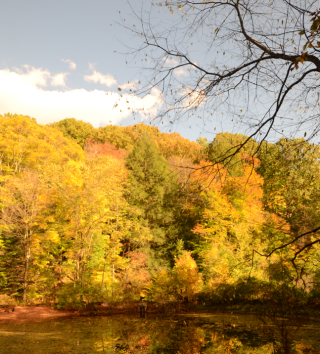Managing Leaves This Fall

Autumn is a beautiful season until it is time to rake leaves. In Fox Chapel Borough, Public Works crews start collecting leaves at residential curbsides in October and continue their collection until late November. This practice has improperly come to be viewed in certain circles as "environmentally friendly." In reality, it is a compromise between collection for landfilling and at-home recycling.
Borough trucks and staff pick up leaves and haul them for composting. The time, vehicle trips, air pollutant emissions, and consumption of fossil fuels stack up, as do the costs merely to recycle and reuse a renewable natural resource (compost).
Trees expect the carbon recharge that leaves give them in their rain shadow. Deciduous leaves are meant to fall, decompose, and recharge the soil each year, giving life to the robust web of fungi and microorganisms that the trees live with. When leaves are removed, this input of energy is cut off, the soil becomes sterile, and our trees become more vulnerable to stressors like drought, infection, pest predation, human damage, and storms.
Healthier soil has the added benefit of reducing lawn and tree care by promoting more vigorous grass growth, reducing the need for chemical fertilizers, and holding moisture to minimize the need for irrigation. When leaves are mulched with a mower, rather than removing them, the decomposing pieces of leaves cover up bare spots between turf plants that are an excellent opening for weed seeds to germinate. Experience has shown that nearly a one-hundred percent decrease in dandelions and crabgrass can be attained after adopting this practice of mulching leaves for just three years.
Mulching leaves can almost entirely offset the need for added fertilizer. Mulching also prevents the threat of the often-cited reason for removing leaves in the first place: the smothering of the lawn. Rather than shading out the grass, the shreds will quickly settle between the blades of grass, preventing competition from below.
As with all forms of solid waste, reduction should be the underlying objective. Leaf waste can easily be reduced, reused, and recycled right where it is produced. Here's how yard waste can become yard wealth:
- Leave Them Be: Let the leaves lie as they fall in heavily wooded areas with native stands of trees. The trees need natural leaf litter. Leaves enrich the soil's nutrients and quality for maximum root growth. Leaving leaves on the ground can also support backyard biodiversity by providing important habitats for animals such as toads, frogs, and pollinators. However, if you have lawn beneath the trees, the leaves must be removed, for the grass may be smothered.
- Make Clean-Up Easier by Mowing Leaves Into Your Lawn – Try mulching leaves into the lawn with a mower to tackle leaves faster. A mulching mower works best, but you can also try a normal mower at the highest blade setting. Mulching leaves break them into small pieces that fertilize the lawn as they decompose.
- Use Leaves as a Resource – In addition to mulching leaves with a mower to fertilize the grass, you can add mulched leaves to landscaping or compost leaves and other yard waste and food scraps.
Plan and Evaluate Your Yard: Reconsidering your routines may require a little time and discipline instead of proceeding as usual. But good, environmentally friendly ideas should emerge. The key is to lessen the waste problem by reducing, reusing, recycling, and rethinking.
